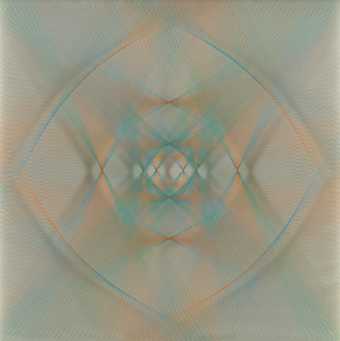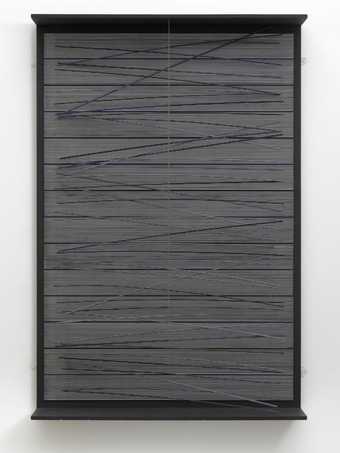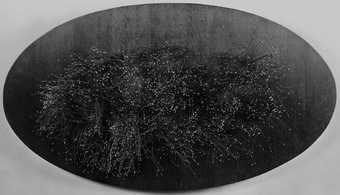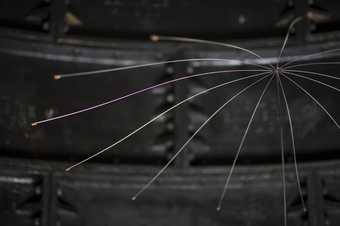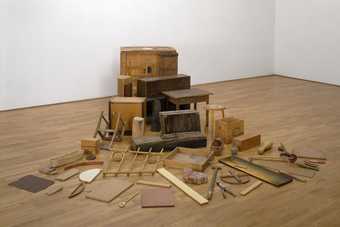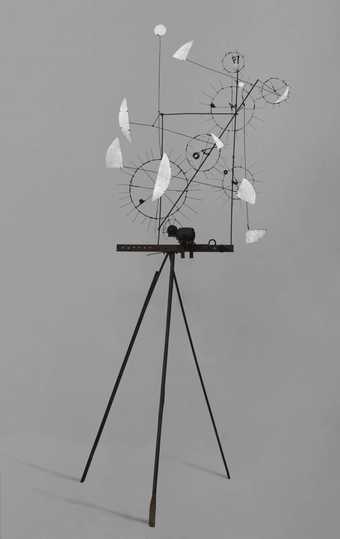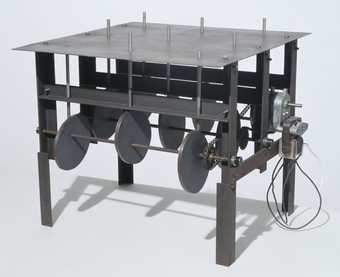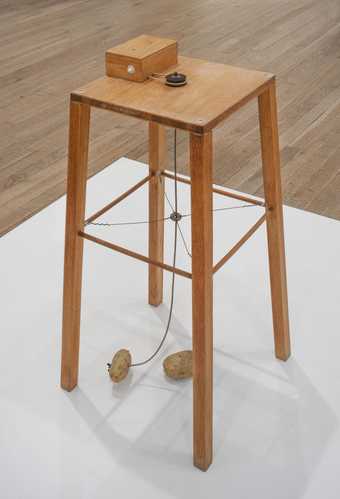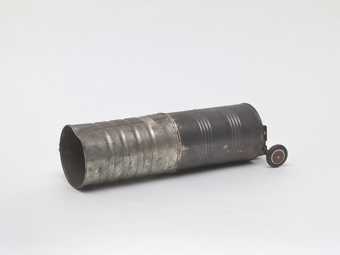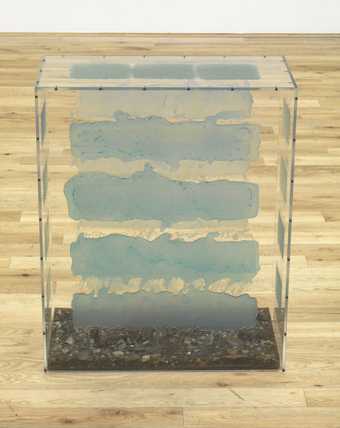Not on display
- Artist
- Jean Tinguely 1925–1991
- Medium
- Metal, plastic, wood and electric motor
- Dimensions
- Object: 515 × 700 × 465 mm
- Collection
- Tate
- Acquisition
- Purchased with assistance from the Friends of the Tate Gallery 1984
- Reference
- T03822
Display caption
Best known for his huge and absurd animated constructions of junk, Tinguely also made small sculptures exploring particular ideas. Here the kind of hand tools he customarily employed are brought together in an electrically-driven three dimensional collage. The appearance of movement and the beat are coordinated in a syncopated way so that the illusion of irregularity is created. The actions of the tools appear purposeful but are pointless in functional terms. Tinguely perhaps had in mind the obsolescence created by mechanical progress. This elegant work is animated by the colourful handles of the tools as well as by movement and sound.
Gallery label, August 2004
Does this text contain inaccurate information or language that you feel we should improve or change? We would like to hear from you.
Catalogue entry
Jean Tinguely born 1925
T03822 Débricollage
1970
Assemblage of household tools and welded metal with electrically driven motor 508 x 762 x 648 (20 x 30 x 25 1/2)
Inscribed in relief with molten welding rod ‘Tinguely' on metal panel attached to motor
Purchased from the artist (Grant-in-Aid) with the help of the Friends of the Tate Gallery 1984
Exh: Jean Tinguely, Anne Berthoud Gallery, Sept.-Oct. 1982 (1, as ‘Debris Collage I'); Forty Years of Modern Art 1945-1955, Tate Gallery, Feb.-April 1986 (not in cat.)
Lit: John Russell Taylor, ‘Tinguely and The Tate strike a blow for jollity', Times, 14 Sept. 1982, p.9, repr. as ‘Debris Collage I'; Friends of the Tate Gallery Report 1983-4, 1984, p.14 repr.
T03822 is constructed from an assortment of manual tools and an electric motor. The base of the work is a structure combining the head of the bit and brace, a cramp and a grip. The tools grouped about the engine are a spoke shave (with two wooden handles), a pair of pliers, an adjustable spanner and an allen key. The other tools are a hack-saw, wrench, combination spanner, nail punch, two spanners, cold chisel, screw-driver and two files. These are the kind of tools that Tinguely would have employed in creating such a work. Apart from the electrical animation of the work T03822 is enlivened by the brilliant colours of the tools' handles, including the red plastic screw-driver handle and the bright yellow handle of the file.
The static parts of the structure are spot welded together. The neatness achieved in this welding is largely responsible for the apparent balance operating within the work, with clumsy and heavy tools seemingly poised on top of one another. Three areas of movement are combined in the work and these are driven by a small electric motor. The first is the adjustable spanner and pliers which are located to the side of the engine itself. The second is the saw which is made to perform very like a piston and appears to saw through the spanner which is poised between it and the file. The third area of movement is created as a by-product of the electric motor. On one side of the motor is a metal plate with Tinguely's name engraved on it. This is driven by the same spindle which prompts the other two areas of movement. Each time the plate revolves, at a certain moment it catches the end of the wooden handle of the hammer and levers the handle up into the air. As it continues to revolve the handle is freed and drops its head, striking the head of the cold chisel, thus introducing a regular beat. The original intention was that the sound and movement should be continuous. At the Tate Gallery the work has been adapted, with the artist's permission, to run from a push button switch for a brief period of time.
The outstanding characteristic of T03822 is the insistent regularity of its movement and sound with each motion repeating the preceding element and with no variation possible. However the appearance of movement and the beat are coordinated in a syncopated way so that the illusion of irregularity is created.
Tinguely has animated domestic, manual tools in a number of other works. Comparable in scale to T03822 is ‘Si la Scie' (‘If the Saw') 1974 (repr. Pontus Hulten, A Magic Stronger Than Death, Milan 1987, p.218) in which a hack-saw similar to that in T03822 is driven by an electric motor. A much more ambitious piece is the ‘Dissecting Machine' 1965 (repr. Hulten 1987, p.157) which combines saws and drills with the dismembered parts of a naked mannequin.
Published in:
The Tate Gallery 1984-86: Illustrated Catalogue of Acquisitions Including Supplement to Catalogue of Acquisitions 1982-84, Tate Gallery, London 1988, p.567
Explore
- abstraction(8,615)
-
- non-representational(6,161)
-
- irregular forms(2,007)
- formal qualities(12,454)
- dysfunction(40)
- sound(54)
- tools and machinery(1,287)
-
- Allen key(1)
- chisel(7)
- engine(21)
- file(1)
- pincers / pliers(12)
- saw(30)
- screw driver(3)
- spanner(4)
- wrench(4)
- social comment(6,584)
-
- machine age(49)
You might like
-
Sue Fuller String Composition 128
1964 -
Jesus Rafael Soto Cardinal
1965 -
Pol Bury 3069 White Dots on an Oval Background
1966 -
Wen-Ying Tsai Umbrella
1971 -
Gerhard von Graevenitz 5 Black Rectangles on White
1973 -
Arman (Armand Fernandez) Condition of Woman I
1960 -
Daniel Spoerri Prose Poems
1959–60 -
Tony Cragg Axehead
1982 -
Jean Tinguely Metamechanical Sculpture with Tripod
1954 -
Barry Martin Metal Surface
1964 -
Barry Martin Double Ringed Movement
1966 -
Bruce Lacey The Womaniser
1966 -
Sigmar Polke Potato Machine - Apparatus Whereby One Potato Can Orbit Another
1969 -
Nam June Paik Can Car
1963 -
Tom Hudson Box of Clouds
1965–72


